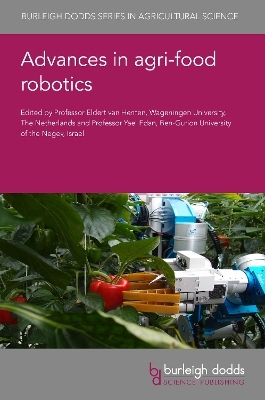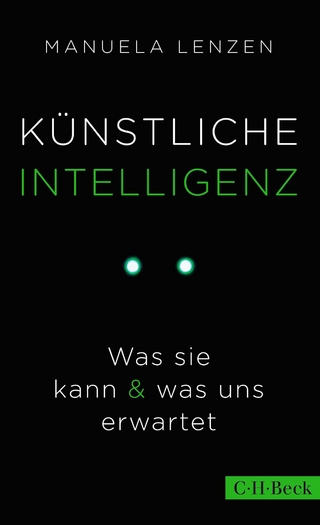
Advances in Agri-Food Robotics
Burleigh Dodds Science Publishing Limited (Verlag)
978-1-80146-277-8 (ISBN)
The global population is expected to reach 9 billion by 2050. Feeding this growing population more sustainably is a huge challenge facing agriculture. Developing agricultural robotics is seen as one potential solution to tackling this challenge.
Advances in agri-food robotics reviews the utilisation of agricultural robots to deal with increasing labour shortages in agriculture whilst bringing greater precision and efficiency into farming operations. The book addresses recent advances in agricultural robotic technologies and how these can be optimised to monitor and manage crop production more effectively, from phenotyping for improved varieties to harvesting the finished product.
In its comprehensive exploration of the technologies available, the book provides farmers with the means necessary to invest – and trust – in agricultural robotics to improve the productivity and profitability of their farm.
Dr Eldert van Henten is Professor of Biosystems Engineering in the Agricultural and Biosystems Engineering Group at Wageningen University and Research, The Netherlands. From 2011 and 2023 he served as co-chair of the IEEE-RAS special interest group on Agricultural Robotics and Automation. In that period he was also co-Chair of the Technical Commission on Agricultural Robotics at euRobotics. He is a member of the CIGR International Commission of Agricultural and Biosystems Engineering. Dr Yael Edan is Professor in Industrial Engineering at the Ben-Gurion University of the Negev, Israel, where she is Head of the Intelligent Robotics Laboratory and Director of the Agricultural, Biological and Cognitive (ABC) Robotics Initiative. Professor Edan is a member of the IEEE-RAS Special Interest Group on Agricultural Robotics and Automation and was a member of the American Society of Agricultural Engineers. She is involved in a number of EU research projects (including the Sweeper and CROPS Projects) and is internationally renowned for her research in such areas as human-robot collaboration. Dr. Reid is a Research Professor in Computer Science and Ag & Bio Engineering, and he is Executive Director in the Center for Digital Agriculture. Reid has more than 35 years of highly accomplished technology leadership experience in industry and academia. In 2017 he was recognized as John Deere Technical Fellow for his contributions in Technology Innovation. From 2020-2022, he was Vice President of Enterprise Technologies for Brunswick Corporation. Dr George Adamides is a Senior Agricultural Research Officer at the Agricultural Research Institute in Cyprus. He holds a B.Sc. and an M.Sc. in Computer Science, both from Western Michigan University. He received his PhD in Information and Communication Systems from the Open University of Cyprus. His research work focuses on smart farming, specifically the introduction and application of robotics and Internet-of-Things, and aspects of Human-Computer Interaction, and Human-Robot Interaction. Professor James Lowenberg-DeBoer holds the Elizabeth Creak Chair in Agri-Tech Applied Economics at Harper Adams University (HAU), Newport, Shropshire, UK. He is responsible for economics in the Hands Free Farm (HFF) team at HAU. He is also past president of the International Society of Precision Agriculture (ISPA) and was co-editor of the journal Precision Agriculture 2016-2022. His research focuses on the economics of agricultural technology, especially precision agriculture and crop robotics. Lowenberg-DeBoer’s research and outreach is founded in hands-on experience in agriculture, including production of maize and soybeans in NW Iowa in the USA. Dr Kees Lokhorst is senior scientist and specialized in Precision Livestock Farming, Robotics. He coordinates the agROBOfood project and is the coordinator of the Dutch agrifoodTEF. He is involved in several national and international research projects (e.g. WASP, BioBusiness, EU-PLF, IoF2020, ERANET ICT Agri, 4D4F, EIP focus group on mainstreaming precision agriculture, Smart Dairy Farming) concerning transition processes in (animal) farming systems. Research is focused on the possibilities of ICT and sensor information to support farmers in their daily management.
Part 1 Technologies: sensing and perception
1.Advances in visual perception for agricultural robotics: Gert Kootstra, Wageningen University, The Netherlands;
2.Advances in world modeling for agri-food robotics: Jordy Senden, Elena Torta and René van de Molengraft, Eindhoven University of Technology, The Netherlands; and Herman Bruyninckx, Eindhoven University of Technology, The Netherlands, Katholieke Universiteit Leuven and Flanders Make, Belgium;
3.Advances in local perception for orchard robotics: Jose Blasco, Centro de Agroingeniería – Instituto Valenciano de Investigaciones Agrarias (IVIA), Spain; and Francisco Rovira-Más, Agricultural Robotics Laboratory (ARL) – Universitat Politècnica de València, Spain;
4.Advances in machine learning for agricultural robots: Polina Kurtser, Örebro University and Umeå University, Sweden; Stephanie Lowry, Örebro University, Sweden; and Ola Ringdahl, Umeå University, Sweden;
Part 2 Technologies: operational aspects
5.Autonomous navigation and path planning for agricultural robots: John F. Reid, University of Illinois at Urbana-Champaign, USA;
6.Advances in human-robot collaboration in agricultural robotics: George Adamides, Agricultural Research Institute, Cyprus; and Yael Edan, Ben-Gurion University of the Negev, Israel;
7.Implementing a digital twin for flexible operation of agricultural robotics: Frits K. van Evert, Trim Bresilla, Ard Nieuwenhuizen, Bram Veldhuisen and Jochen Hemming, Wageningen University & Research, The Netherlands; Giannis Avgoustakis, Spyros Fountas, Michael Koutsiaras and Nikos Mylonas, Agricultural University of Athens, Greece; Suzanne Baron, Agricultural Robotics and Automatization, France; Thanos Dritsopoulos and Markos Legas, Pegasus, Greece; Han Hilbrands and Jeroen Wolters, Smart Agri Technology BV, The Netherlands; Klaas Jan Hommes, Abemec BV, The Netherlands; Panagiotis Karagiannis, Sotiris Makris and George Michalos, University of Patras, Greece; Dimitrios Paraforos and Galibjon Sharipov, University of Hohenheim, Germany; Søren Marcus Pedersen, University of Copenhagen, Denmark; Bertrand Pinel, Terrena Societe Cooperative Agricole, France; Mladen Radisic, Foodscale Hub, Serbia; Juan F. Rascón and Carlos Rizzo, Eurecat, Centre Tecnològic de Catalunya, Spain; Raul Sanchez, Serrater, Spain; Alea Scovill, AgroIntelli, Denmark; Oriol Serra, Giropoma, Spain; and Josep Vidal, Teyme, Spain;
8.Advances in connectivity and distributed intelligence in agricultural robotics: Liisa Pesonen, Natural Resources Institute Finland (Luke), Finland; Daniel Calvo Alonso, Atos, Spain; Juha Backman and Jere Kaivosoja, Natural Resources Institute Finland (Luke), Finland; Jarmi Recio Martinez, Atos, Spain; and Juha-Pekka Soininen, VTT Technical Research Centre of Finland, Finland;
9.Improving fault detection and isolation in agricultural robotics: Nicolas Tricot, Mahmoud Almasri and Roland Lenain, Université Clermont Auvergne, France;
Part 3 Technologies: actuation
10.Advances in mobility platforms for agricultural robots: Renato Vidoni and Giovanni Carabin, Free University of Bozen-Bolzano, Italy; Giuseppe Quaglia and Andrea Botta, Politecnico di Torino, Italy; and Giulio Reina and Rocco Galati, Politecnico di Bari, Italy;
11.Advances in grasping techniques in agricultural robots: George Kantor and Francisco Yandun, Carnegie Mellon University, USA;
12.Advances in soft grasping in agriculture: Ali Leylavi Shoushtari, Wageningen University & Research and Wageningen Robotics, The Netherlands;
13.Advances in agricultural unmanned aerial vehicles: focus on sensing applications: Tarin Paz-Kagan, Ben-Gurion University of the Negev, Israel;
Part 4 Social, ethical and economic aspects
14.Regulatory frameworks and standards for agricultural robotics in the European Union: Andrea Bertolini and Rocco Limongelli, Scuola Superiore di Studi Universitari e di Perfezionamento Sant'Anna - Istituto Dirpolis, Italy;
15.Economics of agricultural robotics: James Lowenberg-Deboer, Harper Adams University, UK;
16.Social and ethical considerations for agricultural robotics: Kirsten Ayris, University of Reading, UK; and David Christian Rose, Cranfield University, UK;
Part 5 Applications
17.Advances in the use of robotics in crop phenotyping: M. Wattad, Technion – Israel Institute of Technology, Israel; V. Alchanatis, Volcani Institute – Agricultural Research Organization, Israel; Y. Edan, Ben-Gurion University of the Negev, Israel; S. Shriki and T. Sandovsky, Volcani Institute – Agricultural Research Organization and Ben-Gurion University of the Negev, Israel; and S. Filin, Technion – Israel Institute of Technology, Israel;
18.Advances in the use of robots in field crop cultivation: Avital Bechar, Agricultural Research Organization, Israel; and Dionysis Bochtis, Institute for Bio-Economy and Agri-Technology (iBO), Greece;
19.Advances in the use of robotics in orchard operations: Manoj Karkee and Qin Zhang, Washington State University, USA; Uddhav Bhattarai, University of California Davis, USA; and Xin Zhang, Mississippi State University, USA;
20.Advances in the use of robotics in greenhouse cultivation: Jochen Hemming and Jos Balendonck, Wageningen University & Research, The Netherlands;
21.Advances in the use of robotics in livestock production: Kees Lokhorst, Wageningen Livestock Research, The Netherlands; and Tomas Norton, Katholieke Universiteit Leuven, Belgium
| Erscheinungsdatum | 28.03.2024 |
|---|---|
| Reihe/Serie | Burleigh Dodds Agricultural Science ; 139 |
| Zusatzinfo | Illustrations |
| Verlagsort | Cambridge |
| Sprache | englisch |
| Themenwelt | Informatik ► Theorie / Studium ► Künstliche Intelligenz / Robotik |
| Weitere Fachgebiete ► Land- / Forstwirtschaft / Fischerei | |
| ISBN-10 | 1-80146-277-1 / 1801462771 |
| ISBN-13 | 978-1-80146-277-8 / 9781801462778 |
| Zustand | Neuware |
| Informationen gemäß Produktsicherheitsverordnung (GPSR) | |
| Haben Sie eine Frage zum Produkt? |
aus dem Bereich


